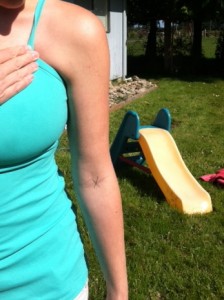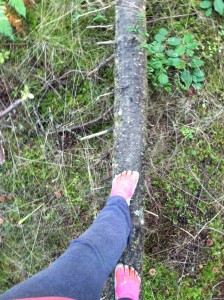Like medicine, exercise has its negative side effects. I know! Hard to believe that something we’re doing for our health has aspects that are physically detrimental, but, the fact remains that, just like pharmaceuticals, there’s a trade-off you have to deal with whether you like it or not.
Treadmills.
Walking is good. In fact, it might be the best thing you can do for your body. But walking is not walking is not walking. And, leaving all that walking aside, using a treadmill comes with some pretty un-cool happenings in the hips (too much flexion) and the butt (minimal use). Just like a space shuttle has to push down into the ground to go up, our body needs to push back in order to go forward. While logging miles on a treadmill may be convenient, the mechanics of walking (read: falling) this way often contribute to spine, hip, and knee problems. Because the belt moves backward, our feet meet little or no resistance when they push off. This requires us to lift our legs out in front of us (holy psoas, Batman!) and then fall forward. The hips, knees, and feet, unfortunately, then have to provide the cushioning for the crash landing.
Alternatives: Um, walking. But not on a treadmill. For a walking or running program with the most natural muscle usage and healthiest results, ditch the machinery, and find a nice local park, neighborhood, or mall to stroll in.
Bicycling.
Biking is a not only better than driving, it’s also faster than walking. But in case you missed it, sitting is a major contributing factor to disease -- which has a lot to do with the continuous flexion of the knees and hips. Meaning, if you’re sitting all day, getting up to “exercise” on your bike still has a similar blood vessel geometry. Meaning, you haven't moved your butt very far off a chair by moving it onto a bike seat.
The damage to the pelvic floor, discs in the spine, psoas, internal pressures and bone density come from necessary geometry to use bicycle seat, the pedals, and the handle bars. In order to not have any body damage, you’d have to stand up out of your seat, retrofit your bike replacing the circular motion of the pedals for some sort of propulsion mechanism that mimicked cross country skiing, while bringing your handle bars up and towards you until your spine could remain in neutral. Which, at that point, would mean you were essentially walking. So far the *best* way I’ve found to use your bike for long term mobility is walking next to it as you push it around. And that will slow you down.
Do you have to sell your bike? No. But if you’re having any of the issues above, swap out some of your riding time for walking time. Get to know the mechanisms of the psoas and how pedaling shortens them puppies up (click). Take a good hard look at big-time cyclists. Look past the tan, hairless skin. The bulging quad and calf muscles. The glistening beads of sweat rolling down their...
Oh. Wait. Sorry. What?
Look beyond the good stuff and instead look at the forward rolling shoulders. That camelesque thoracic spine. The chin, projected forward just so. Just so they don’t crash.
Then take a look at yourself. If your body is slowing turning into the shape of your bike (a la Le Triplets of Bellville aka The Best Movie Ever)

it’s time to intervene and restore those calves, quads, hams, psoas, pelvis, and spine.
3. Sit-ups, crunches, and core exercises.
"The National Institute for Occupational Safety and Health (NIOSH) (1981) has set the action limit for low back compression at 3300 N; repetitive loading above this level is linked with higher injury rates in workers, yet this [load] is imposed on the spine with each repetition of the "sit-up"! - Stuart McGill, author of Low Back Disorders.
Is there anything wrong with doing a crunch or a sit-up every day? Not at all. This movement is very functional. Meaning, you should be able to curl yourself up off of the floor or lift your shoulders and head while lying down so you can see what kind of mischief your kids are getting into while you’re pseudo-napping because they don’t seem to need as much sleep as you do, especially during the night time, or the day for that matter.
Oh. Wait. Sorry. What?
The problem with repetitive core exercise arises when you are doing a ton of the same thing in a row, a ton of them in a row without a coordinated contraction in the pelvic floor, a ton of them after slouching your spine all day in what is, ironically, the same flexed position of a crunch, or a ton of them as your “core workout” for more than a month.
A core-strengthening program should incorporate multiple planes of core motion, dynamic as well as slow and controlled movement, and a good understanding of “how to tell if you’re doing it wrong or not.” Core training programs, you trainers and teachers out there, should begin with exercises that isolate (for the purpose of evaluating what one can or cannot control) but then quickly move on from that point. Once someone can do a crunch or roll up, continuing to do it looks more like a repetitive use injury in the making and less like a healthy activity. Remember the days (15 years ago) when every cardio-aerobics session ended with 200 crunches? We know a lot more now. Turns out, that’s how you hurt a spine, not help one.
Core strength alternatives: Get out of the classroom and take your body into the real world! If your movement sessions consist of exploring the same 10 sq.ft. of your mat in the same 1000 sq. ft of an exercise room, you’ll forever be bemoaning your core. Your core connects your right arm to the left. And the right arm to the left leg. And your shoulder to your toes. And your neck to your pelvis. Which means you’ve got to get moving in a much bigger way then you’ve been used to. The good news is, your core strength (and appearance) will rock.
And before you ask, "what about...", here's the short answer:
Running. More impact-related injury (bones, joints, pelvic floor) than walking. A lot which can be reduced through better alignment and strength in general. Suggestion: If you're a die-hard runner, become a die-hard alignment junkie too, giving special attention to the strength in your feet and the tension in your trunk and legs.
Swimming and Water Exercise. Great way to move your whole body with ease for sore and stiff joints. Not a great way to maintain bone density or improve function strength-to-weight ratio. Lots of repetitive arm use while in internal rotation, which is this position
as opposed to anatomical neutral
See the "x" in my elbow pit? Look carefully. That "x" is over the biceps tendon and should always point forward to ensure you aren't fraying down the tendons in your shoulder or impinging your shoulder joint. Swimming's not so hot for the long-term function of your shoulder tissues (read: shoulder injury). Also interesting, research in thermoregulation and water exercise shows that swimmers tend to store more fat because of the cooling affect of full-body submersion. I find it interesting because when people are trying to start an exercise program and have more weight than strength, water exercise is usually prescribed. An interesting study would be to measure the long-term affects of body composition and water exercise. Anyone interested?
I could go on and on about various types of exercise, but the list is exhausting and the write-up is basically the same. Repetitive motions of a handful of joints in higher-than-natural intensities, with limited joint ranges of motion, for years and years amounts to injury. The benefits of moving are well known. What isn't being taught clearly is this: exercise is not a replacement for movement -- in the same way that eating one food every day or taking a supplement does not replace the biological benefit of a diet with variety. Am I trying to discourage you from moving? Quite the opposite. I am trying to encourage you to increase the size of your movement palate. Your body will last you a whole lot longer and be pain, injury, and disease free by using your tissues in a more natural way.
Exercise is for fun. Movement is a biological requirement. If you're eating dessert, make sure you've had your dinner first!


